Children in Dublin are waiting up to nine years to be seen by primary care psychology services, new figures from the Health Service Executive (HSE) show.
These services are designed for children aged up to 17 who are enduring mild to moderate mental health difficulties.
Each primary care centre usually has a team of occupational therapists, psychologists, nurses and social workers, with services including individual therapy, group-based therapeutic work for children, adolescents and parents, and various types of assessments.
The types of support offered at this level tend to be brief and last for a specified length of time.
READ MORE
It is designed as early intervention before a child might need to be seen by a service such as the Child and Adolescent Mental Health Services (Camhs), which is for young people with moderate to severe mental health difficulties.
However, new waiting list figures released to Cork East Social Democrats TD Liam Quaide following a parliamentary question show many have been waiting more than 12 months for early intervention.
There were 1,838 children waiting for the service in the integrated health area of Dublin North County, with 732 of them waiting more than 12 months. The current longest wait time is nine years and one month.
In Dublin North City and West, there were 2,816 children waiting for the service, with 1,155 of them waiting more than 12 months. The current longest wait time is seven years and nine months.
The HSE said these longest-wait times were “due to appropriate transfers from child disability network teams (CDNT) under the national access policy, with backdating to original date of referral to disability services.
“The longest waiting time for non-transfer cases is approximately three years and 11 months in Dublin North County and three years and six months in Dublin North City and West,” said the HSE.
Meanwhile, in Cavan-Monaghan, 3,550 children are on the waiting list, with 2,345 on it for more than 12 months. The current longest wait time is four years.
In Louth-Meath, 1,447 children were on the waiting list, with 260 of them there for more than 12 months; one child had the longest wait time of three years.
Commenting on the figures, Mr Quaide said the services “around the country are now in deep crisis, with waiting lists that are out of control. Staff morale is on the floor.
“One of the main purposes of primary care is to intervene early, before difficulties become entrenched and the young person might need either Camhs or a CDNT,” he said.
“What the HSE has been doing is transferring large volumes of referrals from CDNTs into primary care, yet not recruiting the staff required to meet this level of need.
“The first step in addressing this crisis is acknowledging its scale. It is essential that the Government commits to a comprehensive recruitment drive in primary care services for young people.”










